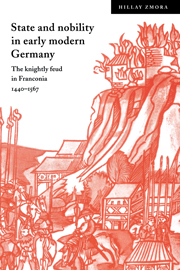Book contents
- Frontmatter
- Contents
- List of figures
- List of tables
- Preface
- List of abbreviations
- 1 The problem of the feud
- 2 The politics of violence: feuding in late medieval Franconia
- 3 The Franconian nobility
- 4 Prosopography of feuding noblemen
- 5 State, nobility, and lordship: the feud interpreted
- 6 The decline of the feud
- A note on Appendixes
- Appendix A Creditors and guarantors of the margraves of Brandenburg
- Appendix B Sample of intermarriages among the noble élite
- Appendix C Individual parameters of feuders (Sample-I)
- Appendix D Family parameters of feuders (Sample-I)
- Appendix E Individual parameters of feuders (Sample-II)
- Appendix F Family parameters of feuders (Sample-II)
- Sources of information for Appendix A
- Sources of Information for Appendixes C and D
- Sources of Information for Appendixes E and F
- Selected bibliography
- Index
- CAMBRIDGE STUDIES IN EARLY MODERN HISTORY
3 - The Franconian nobility
Published online by Cambridge University Press: 29 October 2009
- Frontmatter
- Contents
- List of figures
- List of tables
- Preface
- List of abbreviations
- 1 The problem of the feud
- 2 The politics of violence: feuding in late medieval Franconia
- 3 The Franconian nobility
- 4 Prosopography of feuding noblemen
- 5 State, nobility, and lordship: the feud interpreted
- 6 The decline of the feud
- A note on Appendixes
- Appendix A Creditors and guarantors of the margraves of Brandenburg
- Appendix B Sample of intermarriages among the noble élite
- Appendix C Individual parameters of feuders (Sample-I)
- Appendix D Family parameters of feuders (Sample-I)
- Appendix E Individual parameters of feuders (Sample-II)
- Appendix F Family parameters of feuders (Sample-II)
- Sources of information for Appendix A
- Sources of Information for Appendixes C and D
- Sources of Information for Appendixes E and F
- Selected bibliography
- Index
- CAMBRIDGE STUDIES IN EARLY MODERN HISTORY
Summary
We have concluded that no knight should display gold or embroidered velvet, be it a frock or a mantle; no woman or maiden should have more than four dresses with which to adorn herself … [and] no more than two of [these dresses] should be of velvet … so that poor noblemen could visit tournaments together with their wives and daughters and sisters.
With these sartorial sumptuary regulations, laid down in 1478, the Franconian nobility recognised, and gave articulate expression to, the social and economic fissures within their ranks that threatened to ‘destroy and ruin the nobility’.
To establish the nature of social stratification within the nobility is a project fraught with problems. On the one hand, direct access to nobles' views on this matter is hampered by ideology. Indeed, what elicited the ordinance just quoted was that social reality alarmingly failed to match up to the very ideal tournaments were supposed to celebrate: the solidarity and intrinsic equality of all nobles. As a venerable dictum has it, noblemen get to know each other in one evening better than bourgeois in one month. One can therefore expect nobles to have said either too little or too much about this subject. On the other hand, the validity of the views of modern scholars is also debatable. The main difficulty here is with the analytical categories appropriate for an enquiry into stratification. Although the range of variables is limited, there is no agreement among historians on the relative weight of each. Nor is the character of the relation between these variables clear.
- Type
- Chapter
- Information
- State and Nobility in Early Modern GermanyThe Knightly Feud in Franconia, 1440–1567, pp. 36 - 67Publisher: Cambridge University PressPrint publication year: 1998

